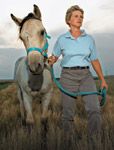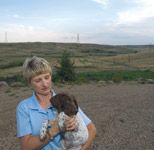Heat wave steamrolls nation
Swelling to 117-degrees, Pierre S.D. shattered temperature records in July according to the National Climactic Data Center. Dr. Vicky Wilkey talks about the summer that burned.
NATIONAL REPORT — Triple-digit temperatures across the nation took a toll on veterinarians and their patients in July, generating an extraordinary amount of small animal emergencies and livestock deaths induced by heat, drought and related stress, experts say.
The onslaught comes with National Oceanic and Atmospheric Administration's National Climactic Data Center (NCDC) report that the United States endured its second-hottest July on record. The world's largest archive of weather data also shows the heat wave broke more than 2,300 daily temperature records. The first seven months of 2006 was the warmest of any year in the United States since records began in 1895, NCDC officials add.

Swelling to 117 degrees, Pierre, S.D. shattered July temperature records according to the National Climactic Data Center. Dr. Vicky Wilkey talks about the summer that scorched.
That includes 117-degrees documented in Pierre, S.D., where Dr. Vicky Wilkey reports house calls for heat victims have been on the rise. While heat stroke remains rare, stress and exhaustion play a factor in many canine patients, she says.
"We've had a couple heat strokes with high fever, dog's that are overexerted and lethargic," she says. "It's been humid and we don't have a breeze. That combination for dogs is not good. Even the indoor dogs are having issues."
Heat rocks agriculture sector
In the dairy capital of the world, the heat has played a more daunting role. Officials in California's Central Valley report 700,000 poultry and 25,000 to 30,000 cattle deaths — about 1 percent of the state's 1.7 million cattle population. The influx of carcasses prompted several area counties to declare states of emergencies considering the backup at rendering facilities. Producers are encouraged to report deaths numbers to county governments, which forward the information to the U.S. Department of Agriculture.
Two hours north of Sacramento, Calif., Dr. Mike Karle, owner of Mid-Valley Veterinary Hospital, reports that while the heat isn't as devastating, his 30 dairy clients have lost their share of cattle.

Sweltering concern: "This summer's been a record-maker as far as I'm concerned," she says. "I think the heat's just getting to all of us; it's even started to take a toll on me."
"We find them dead in the free stall or out in the corral," he says. "That means these producers are losing a lot of money. We're talking $2,000 to $2,500 for lactating cattle and about $1,700 for fresh heifers. And the ones that aren't dead aren't producing."
Texas officials were tallying the number of cattle and swine that succumbed to the July heat wave at presstime. Yet Dr. Daniel Posey suggests the humidity, not heat, causes deaths. Posey, a primary care veterinarian for the state of Texas and clinical assistant professor at Texas A&M's veterinary college, says most area livestock have adapted to high temperatures. The humidity adds additional stress, robbing production from cattle, goats and horses. Drought also is a destructive factor in Texas, he says.
"Any weaknesses these animals have are brought out by environmental stress," he says. "Disease will raise its ugly head."
Direct hit
Modesto sits in the middle of the Valley, where Dr. Kipp Magnussen owns two small animal practices, both seeing plenty of heat-related emergency cases.
"We've seen clients who have lost dogs, even birds," he says. "Quite a few people have died, too. This area is definitely getting hotter, and that's scary. Starting in late June, we had one or two days in the 100s, then wham. We got a heat wave that was the hottest I've ever dealt with."
Animal services agents in Plano, Texas, reported 11 canine heat-related deaths in two weeks. Back in California's Central Valley, Fresno-area practitioner Jon Klingborg, DVM, says when left outdoors, older, arthritic dogs lack the energy and desire to get out of the sun. When heat stroke victims come in, he runs alcohol and ice baths as well as cool intravenous fluids. But the shock to the system often can't be reversed, he says.
"A young healthy police dog was just left in the car, and its air conditioner shut off," Klingborg says. "Within 30 minutes that dog was dead. When we did the autopsy, just putting your hands inside felt like you were in an oven. Everything heats up at the core."
Reaching the limit
South Dakota's State Veterinarian Dr. Sam Holland says the north isn't immune. With temperatures exceeding 100 degrees and humidity hovering at 90 percent, livestock is stressed, he reports. Last month, 25,000 chickens died of heat stroke as well as a few thousand turkeys in the state's 5-million bird industry, Holland adds.
"The industry in our state is used to extremes. We have severe winters and extremely hot summers," he says. "We have been monitoring to see if there's challenges associated with livestock and pets and have noticed that most of the deaths are related to power outages. We'll have to wait and see if this brings on disease."
Newsletter
From exam room tips to practice management insights, get trusted veterinary news delivered straight to your inbox—subscribe to dvm360.